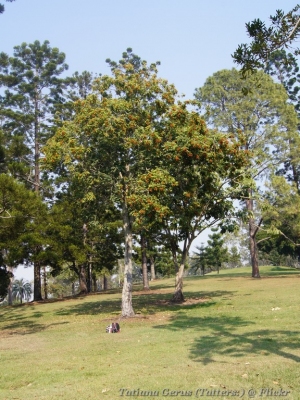Jagera pseudorhus
(A.Rich.) Radlk.
Sapindaceae
Cupania pseudorhus A.Rich.
Common Name: Foam Bark Tree

Cultivated fruiting tree in Brisbane, Australia
Photograph by: Tatters ?

General Information
Jagera pseudorhus is an evergreen tree with an umbrella-shaped crown and ferny, weeping foliage. Usually a small tree up to 10 metres tall, though specimens up to 30 metres tall have been recorded[
694- Title
- Australian Rainforest Plants Volumes 1 - 6
- Publication
-
- Author
- Nicholson N. & H.
- Publisher
- Terania Rainforest Publishing; New South Wales.
- Year
- 2007
- ISBN
- 9-78095894-3628
- Description
- Beautiful set of booklets with a terse description of over 600 species and their habitat, often including some of their uses and notes on their cultivation, plus at least one, excellent photograph.
].
The saponins in the bark have been used as soap and as a foaming agent[
46- Title
- Dictionary of Economic Plants.
- Publication
-
- Author
- Uphof. J. C. Th.
- Publisher
- Weinheim
- Year
- 1959
- ISBN
- -
- Description
- An excellent and very comprehensive guide but it only gives very short descriptions of the uses without any details of how to utilize the plants. Not for the casual reader.
].
Known Hazards
The seed capsules are covered in fine, penetrating hairs that make handling them unpleasant[
694- Title
- Australian Rainforest Plants Volumes 1 - 6
- Publication
-
- Author
- Nicholson N. & H.
- Publisher
- Terania Rainforest Publishing; New South Wales.
- Year
- 2007
- ISBN
- 9-78095894-3628
- Description
- Beautiful set of booklets with a terse description of over 600 species and their habitat, often including some of their uses and notes on their cultivation, plus at least one, excellent photograph.
].
All parts of the plant, but especially the bark, contain saponins46]. Although poisonous, saponins are poorly absorbed by the human body and so most pass through without harm. Saponins are quite bitter and can be found in many common foods such as some beans. They can be removed by carefully leaching in running water. Thorough cooking, and perhaps changing the cooking water once, will also normally remove most of them. However, it is not advisable to eat large quantities of food that contain saponins. Saponins are much more toxic to some creatures, such as fish, and hunting tribes have traditionally put large quantities of them in streams, lakes etc in order to stupefy or kill the fish[
K- Title
- Plants for a Future
- Author
- Ken Fern
- Description
- Notes from observations, tasting etc at Plants For A Future and on field trips.
].
Botanical References
Range
Australia - New South Wales and Queensland.
Habitat
Lowland, coastal rainforests, usually in better soils, and along the banks of creeks[
156- Title
- Useful Wild Plants in Australia.
- Publication
-
- Author
- Cribb. A. B. and J. W.
- Publisher
- William Collins Pty Ltd. Sidney
- Year
- 1981
- ISBN
- 0-00-216441-8
- Description
- A very readable book.
,
694- Title
- Australian Rainforest Plants Volumes 1 - 6
- Publication
-
- Author
- Nicholson N. & H.
- Publisher
- Terania Rainforest Publishing; New South Wales.
- Year
- 2007
- ISBN
- 9-78095894-3628
- Description
- Beautiful set of booklets with a terse description of over 600 species and their habitat, often including some of their uses and notes on their cultivation, plus at least one, excellent photograph.
].
Properties
| Edibility Rating |      |
| Other Uses Rating |      |
| Habit | Evergreen Tree |
| Height | 8.00 m |
| Cultivation Status | Wild |
Cultivation Details
Succeeds in fairly moist, subtropical to tropical lowland areas.
Edible Uses
The saponins in the bark have been used as a foaming agent to put a 'head' on cordials[
46- Title
- Dictionary of Economic Plants.
- Publication
-
- Author
- Uphof. J. C. Th.
- Publisher
- Weinheim
- Year
- 1959
- ISBN
- -
- Description
- An excellent and very comprehensive guide but it only gives very short descriptions of the uses without any details of how to utilize the plants. Not for the casual reader.
].
Medicinal
None known
Other Uses
All parts of the plant contain saponins and produce foam if agitated in water[
694- Title
- Australian Rainforest Plants Volumes 1 - 6
- Publication
-
- Author
- Nicholson N. & H.
- Publisher
- Terania Rainforest Publishing; New South Wales.
- Year
- 2007
- ISBN
- 9-78095894-3628
- Description
- Beautiful set of booklets with a terse description of over 600 species and their habitat, often including some of their uses and notes on their cultivation, plus at least one, excellent photograph.
]. The saponins are most concentrated in the bark, and this has been used as a soap.
Propagation
Seed - it has a limited viability and needs to be sown when ripe. However, it is easier to wait until the seed capsules have dried and opened to obtain the seed. Germination usually occurs within 2 weeks[
694- Title
- Australian Rainforest Plants Volumes 1 - 6
- Publication
-
- Author
- Nicholson N. & H.
- Publisher
- Terania Rainforest Publishing; New South Wales.
- Year
- 2007
- ISBN
- 9-78095894-3628
- Description
- Beautiful set of booklets with a terse description of over 600 species and their habitat, often including some of their uses and notes on their cultivation, plus at least one, excellent photograph.
].
If you have any useful information about this plant, please leave a comment. Comments have to be approved before they are shown here.
 Useful Tropical Plants Database 2014 by
Ken Fern,
web interface by
Ajna Fern
with help from
Richard Morris.
Useful Tropical Plants Database 2014 by
Ken Fern,
web interface by
Ajna Fern
with help from
Richard Morris.